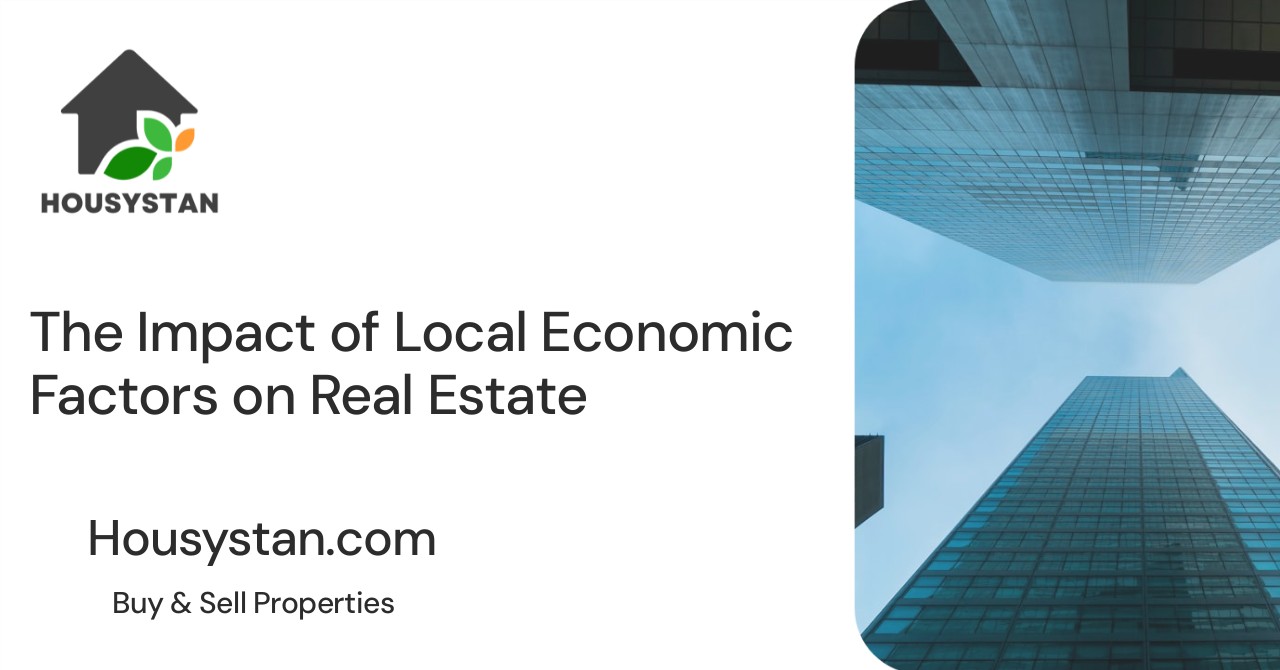The Impact of Local Economic Factors on Real Estate
Read latest blogs and articles from Housystan

The Information mentioned here was last updated on:
14/12/2025Understanding the Impact of Local Economic Factors on Real Estate
Real estate is often seen as a safe investment, but there are many variables that can influence property values and market dynamics. Local economic factors, in particular, play a significant role in shaping real estate markets. Understanding these elements can help both buyers and sellers make informed decisions and predict trends in property prices.
Key Economic Influencers in Real Estate
- Verified Tenants/Buyers
- Unlimited Property Listing
- Zero subscription/charges fee
Employment Rates
Employment levels within a community significantly impact the real estate market. Here’s how:
- Job Availability: Areas with thriving job markets typically attract more residents, boosting demand for housing.
- Income Levels: Higher employment often corresponds with increased income levels, leading to a greater capacity for individuals to purchase homes.
- Job Diversity: Diverse industries within a region can stabilize the market by reducing dependency on a single economic sector.
Inflation and Interest Rates
- Inflation: Rising inflation can erode purchasing power, leading to decreased affordability in real estate.
- Interest Rates: Lower interest rates often encourage borrowing, making it easier for buyers to secure mortgages. Conversely, higher rates can deter potential homeowners.
Population Growth
Population growth is closely tied to housing demand:
- Migration Patterns: Influxes of new residents can result in higher demand for housing, thereby increasing property values.
- Demographic Shifts: Aging populations versus younger, mobile demographics can alter the types of properties in demand (e.g., single-family homes vs. condominiums).
Local Government Policies and Taxes
The policies set by local governments can also significantly influence the real estate market:
- Zoning Laws: Regulations on land use can restrict or enable property developments, affecting supply.
- Tax Incentives: Tax credits or deductions related to home ownership can stimulate market activity.
- Property Taxes: High property taxes can be a deterrent for potential buyers, influencing overall demand.
Analyzing Local Real Estate Markets
When exploring real estate investment or purchase, evaluating local economic conditions is crucial. Here’s what to consider:
Housing Supply and Demand
Understanding the balance between supply and demand in a local market can offer insights into potential price fluctuations:
- Inventory Levels: A high inventory might suggest a buyer’s market, while low inventory indicates a seller’s market.
- New Construction: The rate of new housing developments can signify future supply adjustments.
- Vacancy Rates: Low vacancy rates usually point to higher demand.
Economic Health Indicators
Several indicators can provide insights into the economic health of a community:
- Unemployment Rate: A low unemployment rate tends to indicate a stable economy, which is beneficial for real estate markets.
- GDP Growth: Regions experiencing strong GDP growth often see real estate appreciation.
- Business Investments: New enterprises and expansions can bode well for local real estate by bringing in new residents and increasing demand.
Practical Tips for Buyers and Sellers
For Buyers:
- Research Local Trends: Focus on neighborhoods with positive economic trends, such as job growth and infrastructure projects.
- Consult Local Experts: Real estate agents with local knowledge can provide valuable insights into future market conditions.
- Consider Long-Term Stability: Look at areas with diverse economies and steady population growth for long-term investment stability.
For Sellers:
- Time the Market: Monitor economic indicators to determine the optimal time to sell to maximize profits.
- Enhance Property Value: Investing in renovations or energy-efficient upgrades can make a property more appealing.
- Leverage Local Data: Stay informed about local economic changes and adjust pricing strategies accordingly.
Future Outlook for Real Estate Markets
The future of real estate is inherently tied to the evolving landscapes of local economies. As technology advances and urban centers develop, several trends may emerge:
The Rise of Smart Cities
- Technology Integration: Smart cities might increase demand for tech-enabled homes.
- Sustainability Practices: Eco-friendly developments could become increasingly attractive, potentially impacting property values.
Remote Work Trends
The shift towards remote work is expected to have lasting implications:
- Suburban and Rural Growth: Many workers are moving away from congested cities, increasing real estate activity in suburban and rural areas.
- Flexible Space Needs: Properties with home office capabilities are becoming more desirable.
Infrastructure Investment
Government investment in infrastructure can significantly boost real estate markets:
- Transportation Projects: Improved accessibility through new transit routes or highways can raise property values.
- Community Enhancements: Parks, schools, and community centers often lead to increased demand in surrounding markets.
Final Thoughts
Understanding local economic factors is crucial for navigating the real estate market effectively. Both buyers and sellers stand to benefit from recognizing how employment rates, population growth, and government policies can influence property values. By staying informed and leveraging this knowledge, individuals can make strategic real estate decisions that align with economic trends. For more insights into real estate tips and local market trends, explore our collection of guides and expert interviews, designed to empower you in your property journey.